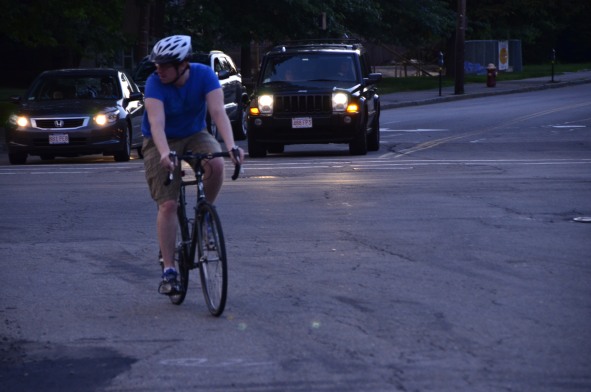
Sharing the road is really catching on. Increasing numbers of drivers are attempting to interact with cyclists in a meaningful way. Or so it seems.
Actually, many drivers are still oblivious to bicycles. But there are those who appear to be aware of them, even if they’re uncertain how to safely drive around them.
This uncertainty is part of the problem. It’s as if they aren’t sure how to position their cars to maneuver around a bicycle.
As all cyclists know, drivers speed up to pass a bicycle riding on their right side and then slow down to turn directly in front of the moving bike. It’s unlikely that drivers do this to harm cyclists. More likely, they misjudge the speed of the bike and assume that they can turn before the bike reaches them.
Drivers haven’t caught on to how fast bikes move, or more importantly, how to judge a bike’s speed. Riders vary significantly in how fast they ride. Fitness level, bicycle type and weight, and age all factor in to how fast a cyclist can ride.
Some drivers don’t realize this. Bikes all seem the same to them. Perhaps this is what started the trend of cars stopping when they should be going.
The first time I noticed this phenomenon, I attributed it to a lone confused driver. This guy couldn’t make up his mind whether to proceed or whether to let me pass. Consequently, he braked and accelerated and braked again.
His car was jerking from the stop and go driving. I imagined it would lurch into me if I rode in front of it, so I was wary of the driver’s invitation to go first.
It wasn’t until the second time a driver stopped to accommodate me that I began to see a trend. Drivers were conscious of a bicycle in their surroundings and wanted to avoid a conflict.
Once I was aware of this trend, I watched more closely for examples of it. While waiting for a light, for instance, I saw a driver wave a bicycle on, rather than continuing on her way. She stopped and waited.
Showing courteous behavior towards the cyclist was nice — and a refreshing change. Courtesy, on Boston roads, is rare enough between cars and pedestrians, but it’s essentially unheard of for cyclists.
Being the recipient of this courtesy is an honor. However, it comes with a down side. When cars hesitate, or let bicycles go in front the them arbitrarily, sharing the road becomes unpredictable.
No good way exists for cyclists to know which drivers will unnecessarily stop to let them pass. So many drivers accelerate to beat a cyclist to a certain point on the road that it becomes second nature for cyclists to hesitate before passing or turning in front of a car.
What, then, is a cyclist to do when a driver invites him or her to go first? Going first isn’t always a good idea. Other cars might try to pass the stopped car to avoid having to stop.
This could put the cyclist in a dangerous position since the passing car might not be able to see the cyclist. And any car behind the car accommodating the cyclist might not brake in time if that driver isn’t expecting the car in front of him to stop suddenly.
If the car gets rear-ended, the effect on traffic could be catastrophic for the cyclist. Other cars might try to avoid the two cars who have collided. And the cyclist would be in the middle of all of this chaos.
Surely, a cyclist would want to avoid such a situation. But how can he do this without offending the driver who is trying to share the road?
Communication is paramount in such situations. When I found myself in this position, I nodded to the driver, thanked him for considering my interests, and waved him on.
A solution of this type isn’t ideal. It may train the driver to assume that he always has the right of way and that cyclists will yield to him. That may work against cyclists in the long run, but it is definitely the safe way to go in the short run.
Going in front of a waiting car, when it is safe to do so, will have the opposite effect: it will show drivers that cyclists have rights and are willing to assert those rights on the roads. This can condition drivers to consider cyclists as they navigate on busy roads.
Even if this stopping for cyclists is a small trend, it is changing the nature of bicycles sharing the road with cars. For every car that is aware of cyclists and treats them as if they have rights, bicycles move one step closer to parity with motor vehicles.
It will be a slow, long battle until cyclists approach equal rights. In the meantime, let’s revel in the joy of knowing that some drivers have come to accept cyclists as fellow vehicle operators and are willing to extend them the same courtesy they would show a driver. It’s not much, but it’s a start.


